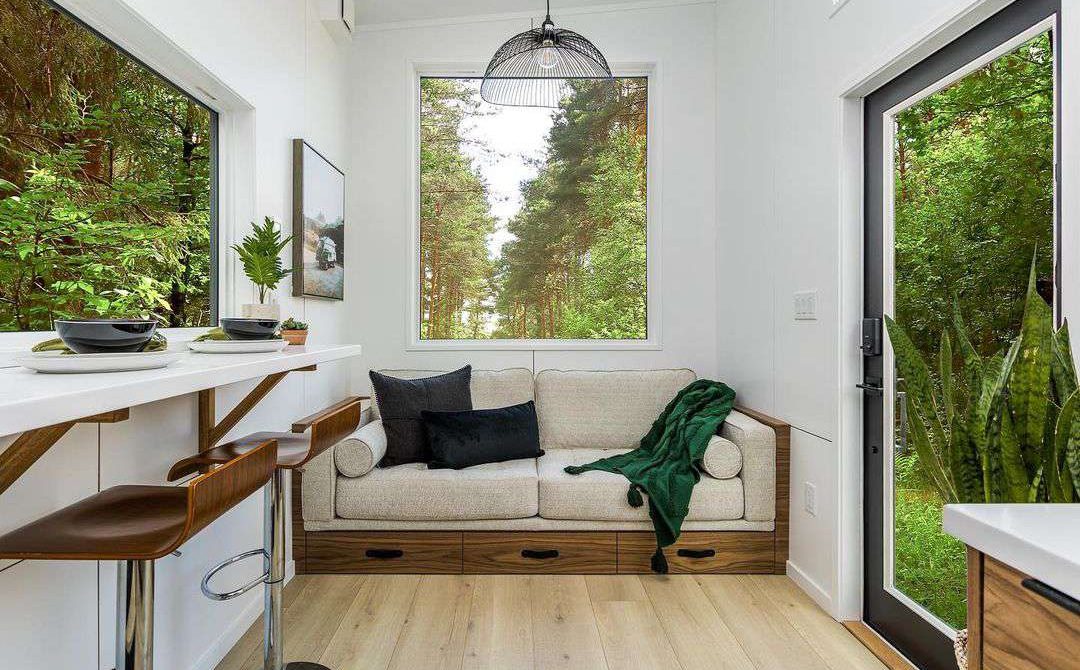Tiny home interiors maximize space and functionality. Clever design choices like built-in storage and multifunctional furniture make these homes efficient. Every square foot is utilized to meet the owner’s needs.
Natural light is important in tiny homes. Large windows and skylights make the space feel bigger. Compact appliances and minimalist decor keep the interiors simple and uncluttered.
This blog will give you tips for maximizing light and space in tiny home interiors, from clever storage solutions to effective use of natural light.
Utilizing Natural Light
Natural light is key to making small spaces feel bigger. Large windows let in lots of light, giving a sense of openness. This is an easy way to make your tiny home’s interior feel more spacious.
Skylights are another great option. They let sunlight pour in from above, brightening up the space even more. This can be especially useful in rooms without many windows.
Select light-colored interiors to reflect natural light. This enhances the brightness in your home. Combine natural light with interior lighting to maintain a well-lit space in the evening.
Multipurpose Furniture
Multipurpose furniture is essential in tiny homes. It saves space and adds functionality. A sofa bed is great for small spaces.
A foldable dining table can be used for meals and work. When not in use, it can be folded away. This is one of the best space-saving tips for tiny homes.
Storage ottomans are another smart choice. They offer seating and hidden storage. These pieces help keep your home organized and clutter-free.
Vertical Storage Solutions
Vertical storage solutions are perfect for making the most of limited space. Shelves and cabinets that go up to the ceiling are ideal. Using the walls for storage keeps floors clear and makes the room feel bigger.
Tall bookcases are great small space solutions. They provide plenty of storage without taking up much floor area. Add baskets or boxes to keep things organized on the shelves.
Wall-mounted hooks and racks are also useful. Hang items like coats, bags, and utensils to save space. This keeps things handy and the room tidy.
Reflective Surfaces
Reflective surfaces are excellent for enhancing light in tiny homes. Mirrors are a popular choice because they reflect both natural and artificial light. Placing a large mirror opposite a window can double the amount of sunlight entering the room.
Glass furniture also adds reflectivity, making spaces appear bigger. A glass coffee table or shelving unit can enhance the brightness without adding bulk. These pieces blend smoothly with other furniture, maintaining a sleek look.
Glossy finishes on walls or cabinets can also help light travel further. Light bounces off shiny surfaces, amplifying brightness. This simple change can dramatically impact the feel of your tiny home, making it seem more open and airy.
Sliding Doors Over Hinged Doors
Sliding doors are a great space-saving solution for tiny homes. They don’t need extra room to swing open, unlike hinged doors. This makes them ideal for tight spaces where every inch matters.
These doors can also make your home look modern and sleek. With a variety of materials and finishes available, you can find a sliding door to match any interior style. They can even double as room dividers, adding versatility to your space.
Additionally, sliding doors allow for smoother transitions between rooms. They can be used for closets, bathrooms, and bedrooms to maximize floor space. This helps keep the home open and clutter-free.
Light-Weight Fabrics and Materials
Light-weight fabrics and materials are crucial for tiny home interiors. They help keep the space from feeling cramped and heavy. Choosing the right materials can make a noticeable difference in comfort and aesthetics.
Linen and cotton are excellent choices for upholstery and curtains. These fabrics are breathable, easy to clean, and provide a light and airy feel. They also come in various colors to match any design scheme.
For furniture, consider materials like light-weight wood or aluminum. These options are durable yet easy to move around. This flexibility allows for reconfiguration of the space as needed, adding to the functionality of your tiny home.
Open Shelving in the Kitchen
Open shelving in the kitchen is perfect for maximizing small spaces. It keeps everything within reach, saving time when cooking. Plus, it makes the kitchen look open and airy.
Arranging items neatly on open shelves adds to the decor. Display colorful dishes and glassware for a pop of color. Use matching containers to keep things organized and tidy.
Open shelves also make cleaning easier. There are no doors to deal with, so it’s simple to wipe down shelves. By maximizing small spaces, open shelving keeps the kitchen efficient and stylish.
Choosing the Right Color Palette
Choosing the right color palette is key in tiny homes. Light colors make spaces feel bigger and brighter. White, light gray and pastels are good choices for walls and furniture.
Dark colors can make the space feel small. Use darker shades for accents or in small areas. This helps create a balanced look without overwhelming the space.
If you are looking for pre-designed units, Minimal Living Concepts’s tiny homes offer great color choices. Their designs use light colors to make the most of small spaces. This makes your tiny home feel open and airy.
Minimalist Design Approach
The minimalist design approach is perfect for tiny homes. This style values simplicity and function over excess. By reducing clutter, you create a clean and open space.
The key to minimalism is to keep only what you need. Use neutral colors and simple decor. This makes your home feel calm and spacious.
Invest in multifunctional furniture. A bed with storage underneath or a fold-out desk is useful. This ensures every piece serves a purpose, maximizing the space.
Maximizing Tiny Home Interiors for Ultimate Comfort
Creating the perfect tiny home interiors is all about clever design. Utilize natural light and multifunctional furniture to maximize space. Embrace minimalism for a clean, open feel.
Use vertical storage solutions and reflective surfaces to enhance brightness and roominess. Choose light colors and lightweight materials. These steps will make your tiny home both functional and beautiful.
We hope this guide has been a good resource. Make sure to check out the rest of our site for more informative blog posts.
Stay in touch to get more news & updates on Buzz Slash!




